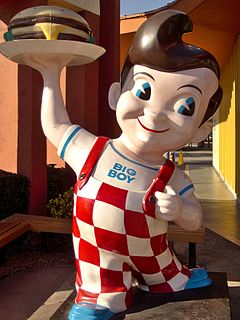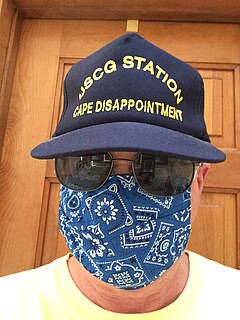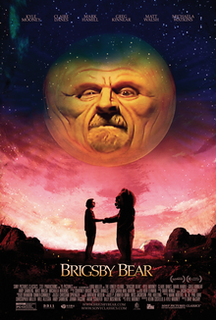Costume is the distinctive style of dress or cosmetic of an individual or group that reflects class, gender, profession, ethnicity, nationality, activity or epoch. In short costume is a cultural visual of the people.

A mascot is any human, animal, or object thought to bring luck, or anything used to represent a group with a common public identity, such as a school, professional sports team, society, military unit, or brand name. Mascots are also used as fictional, representative spokespeople for consumer products.

Audio-Animatronics is the registered trademark for a form of robotics animation created by Walt Disney Imagineering for shows and attractions at Disney theme parks, and subsequently expanded on and used by other companies. The robots move and make noise, but are usually fixed to whatever supports them. They can sit and stand but usually cannot walk. An Audio-Animatronic is different from an android-type robot in that it uses prerecorded movements and sounds, rather than responding to external stimuli. In 2009, Disney created an interactive version of the technology called Autonomatronics.

Animatronics refers to mechatronic puppets. They are a modern variant of the automaton and are often used for the portrayal of characters in films and in theme park attractions.

A disguise can be anything which conceals or changes a person's physical appearance, including a wig, glasses, makeup, fake moustache, costume or other items. Camouflage is a type of disguise for people, animals and objects. Hats, glasses, changes in hair style or wigs, plastic surgery, and make-up are also used.

Fursuits are custom-made animal costumes owned and worn by cosplayers and members of the furry fandom, commonly known as "furries"; a furry who wears a fursuit is called a fursuiter. The term is believed to have been coined in 1993 by Robert King. Unlike mascot suits, which are usually affiliated with a team or organization, fursuits represent an original character created by their wearer, and are often better-fitting and more intricately crafted, with features such as a moving jaw. Fursuits are made in a wide range of styles, from cartoonish to highly realistic.

Misha, also known as Mishka or The Olympic Mishka, is the name of the Russian Bear mascot of the 1980 Moscow Olympic Games. He was designed by children's books illustrator Victor Chizhikov.

Kuma, literally meaning "bear", is the name of two characters within the Tekken fighting game series released by Namco Bandai Games. Kuma I was introduced in the first Tekken and returned for Tekken 2, while Kuma II was introduced in Tekken 3 and has returned for all subsequent games. Both of them are tame bears, bodyguards to Heihachi Mishima, as well as father and son towards each other. The female Panda (パンダ) was introduced in Tekken 3 as a palette swap of Kuma, returning for subsequent games.

James Hadley Snyder, better known as Dan Green, is an American voice actor, voice director, and screenwriter. He is best known for being the voice of Yugi Muto/Yami Yugi for Yu-Gi-Oh! Duel Monsters, the anime series version of Yu-Gi-Oh!, as well as all of the character's U.S. series appearances.

Representations of gorillas are common in popular culture in the Western world with the full range of electronic media having gorillas as mascots, gorillas behaving like humans, and humans behaving like gorillas.

Cat suits are a type of costumed character or creature suit resembling a cat, or any member of the Felidae. They are one of the most popular choices of mascot, and both stylized and realistic cat suits are commonly used in film and on stage, due to the cat's prominence in human culture. They are also used for advertising, entertainment and educational purposes.

Gorilla suits are a type of creature suit resembling a gorilla. The gorilla suit is a popular Halloween and costume party costume, and is also used as a source of humour, while more realistic suits have been used both to represent real gorillas in film and on stage.

A costumed performer or suit performer wears a costume that usually, covers the performer's face, typically to represent a non-human character such as a mascot or cartoon character. These range from theme park "walk-around" or "meetable" characters, the mascots of corporations, schools, or sports teams to novelty act performers. Some costumes cover the performer's face especially those in theme parks.

Jim Henson's Creature Shop is a special/visual effects company founded in 1979 by puppeteer Jim Henson, creator of The Muppets. The company is based out of Burbank, California, United States.

Five Nights at Freddy's: The Silver Eyes is a 2015 horror mystery novel written by Scott Cawthon and Kira Breed-Wrisley. It is based on Cawthon's bestselling horror video-game series Five Nights at Freddy's, and is considered by Cawthon to be separate-canon to the events that occurred in the game series, as well as his and her debut novel.

Creature suits are realistic costumes used to disguise a performer as an animal, monster, or other being. They are used in film, television, or as costumed characters in live events. Unlike mascots, they are often made with a high degree of realism. In contrast with prosthetic makeup, which is applied to an actor's skin, the wearer is not normally visible outside their movements controlling the costume, although in some cases, part of the wearer's body is still visible.

Brigsby Bear is a 2017 American comedy-drama film directed by Dave McCary in his feature directorial debut, written by Kevin Costello and Kyle Mooney, and starring Mooney, Claire Danes, Mark Hamill, Greg Kinnear, Andy Samberg, Matt Walsh, and Michaela Watkins. It tells the story of a captive man raised in a bunker since he was a baby being rescued by the authorities where he obsessed over a children's television program titled Brigsby Bear. When he realizes the show was created by his captor that he called his dad, his fascination leads him to finish the storyline himself.

Dinosaur suits are a type of costumed character or creature suit resembling a dinosaur. Dinosaur suits are also called dinosaur costumes. Such costumes were used in film and television and as mascots for decades, reflecting dinosaurs' prominence in the arts and entertainment. Usually operators use two cable-pulled handle to control the motions. Realistic dinosaur suits also gained popularity for live shows following the success of Walking with Dinosaurs − The Arena Spectacular. An experienced performer can make lifelike movements with a dinosaur suit. They are also used in theme parks and in an educational context at various museums. Inflatable dinosaur suits have been used for pranks, gags, and protests.

















